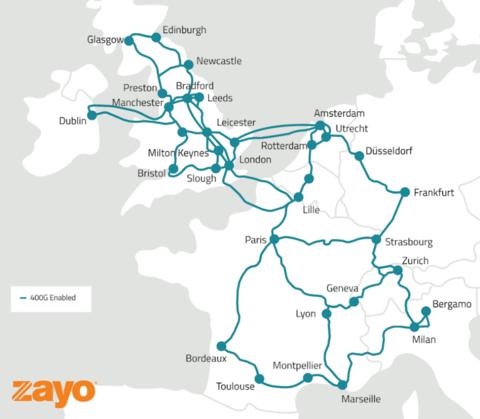Zayo Group just marked a milestone with its fiber backbone in Europe, announcing the long-haul network there is now “fully 400G enabled.”
Zayo’s European network, which is built on five different subsea cables, powers 2,500 on-net buildings, 125 core points of presence (PoPs) and 16 metro fiber markets.
Yannick Leboyer, chief operating officer at Zayo’s Europe division, said the 400G upgrades enable the company to connect “all the major data centers across all the metros we cover in Europe.”
“So we can take any customers from say, London to Frankfurt to Amsterdam or Marseille on 400G, and then that’s the bulk of it,” he told Fierce. “Typically, this is where most of the demand for 400G is going to be from data centers to data centers.”

Some of the “early adopters” of 400G are new fiber players in the U.K., Leboyer went on to say, because those ISPs “didn’t have any legacy network.” They would use a company like Zayo to connect data centers in “key cities” and then concentrate their network traffic in those cities.
Zayo is also prepping 400G upgrades for its North American backbone, which is scheduled to be fully 400G enabled by the end of 2024.
Leboyer noted Zayo’s North American network has “far more reach” than the one in Europe, thus it’s taking more time for Zayo to add the 400G capabilities there.
“There’s far more routes in North America and far more metropolitan cities connected as well,” he said.
Zayo VP of Product Management Chaz Kramer told Fierce in April roughly 80% of the company’s services are 100G, but it’s continuing to add more 400G routes to its network.
The desire for 400G connectivity seems to be growing. Zayo in its release cited Omdia research indicating 74% of companies rely on 400G connect with enterprise locations or cloud providers, while 58% rely on it for communication between data centers.
Using 400G services is also more “energy efficient” than stacking a network with 100G capabilities, Leboyer said.
“Typically today, if you do not buy 400G you would be buying 100G…therefore you’d be buying four times 100G to get to the same sort of outcome,” he said, with the latter method “consuming four times as much power.”
“There’s also an economical impact because as you know in Europe, our prices have been pretty high in the last 18 months,” Leboyer added. “So the business case for migrating to 400G becomes more interesting as soon as you start to save on power – both along your way and in the data center.”
Zayo isn’t stopping at 400G, as it’s already exploring 800G wavelengths. In March 2022, Zayo announced it used Infinera’s ICE6 tech to successfully complete the world’s longest terrestrial 800G optical wavelength in a commercial network.
The 800G capabilities were tested on a route from Springville, Utah, to Reno, Nevada. Leboyer said as far as he knows, the company hasn’t trialed 800G on any other routes as it’s “more focused on finishing the deployment of 400G across North America.”